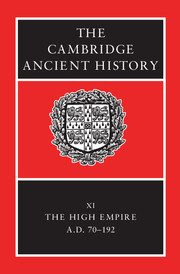Book contents
- Frontmatter
- PART I NARRATIVE
- PART II GOVERNMENT AND CIVIL ADMINISTRATION
- PART III THE EMPIRE
- PART IV ROME, ITALY AND THE PROVINCES
- PART Va ECONOMY AND SOCIETY
- PART Vb ART AND CULTURE
- 30 Literacy
- 31 Literature and sophistic
- 32 Philosophy
- 33 Medicine
- 34 Art and architecture
- 35 Religion
- Chronological Table
- BIBLIOGRAPHY
- Index
- 1 The Roman world in the time of Marcus Aurelius
- 7 The Danube provinces
- References
35 - Religion
from PART Vb - ART AND CULTURE
Published online by Cambridge University Press: 28 March 2008
- Frontmatter
- PART I NARRATIVE
- PART II GOVERNMENT AND CIVIL ADMINISTRATION
- PART III THE EMPIRE
- PART IV ROME, ITALY AND THE PROVINCES
- PART Va ECONOMY AND SOCIETY
- PART Vb ART AND CULTURE
- 30 Literacy
- 31 Literature and sophistic
- 32 Philosophy
- 33 Medicine
- 34 Art and architecture
- 35 Religion
- Chronological Table
- BIBLIOGRAPHY
- Index
- 1 The Roman world in the time of Marcus Aurelius
- 7 The Danube provinces
- References
Summary
The victory of Vespasian marked an epoch in political, not in religious history. The subsequent period saw the continuation rather than the beginning of religious developments. The most important cause of change was probably the existence of the Roman empire itself. The establishment of Roman administration was accompanied by tremendous social upheavals, particularly in the West. The Roman army and civil urbanization introduced the worship of Roman gods. Native cults were romanized. It amounted to an explosive expansion of Roman religion. But this was not all. Men from all over the empire came to Rome for a wide variety of reasons bringing their religion, forming religious communities. From Rome and Italy these imported religions spread to the provinces with the result that cults from the Greek East became established in many places in the West. In the eastern provinces the dynamic factors were not quite the same. Further hellenization took the role performed by romanization in the West, and there was a great ferment of ideas.
An observer of the religious life of the empire would have been struck by its variety. This was partly a result of the population being composed of many different status-groups. As in many other societies, group solidarity found religious expression. Groups large and small had their worship, from the gods of the Roman state to the protecting spirit of locality or home. Religion helped to integrate slaves and freedmen into society. They worshipped the lares of the family. In a large household they might form associations, under their master's patronage, for this purpose and to make sure that members received proper burial.
- Type
- Chapter
- Information
- The Cambridge Ancient History , pp. 984 - 1008Publisher: Cambridge University PressPrint publication year: 2000
References
- 12
- Cited by

